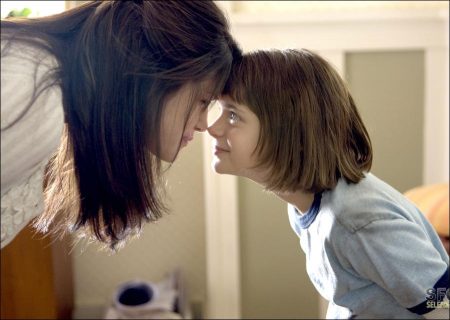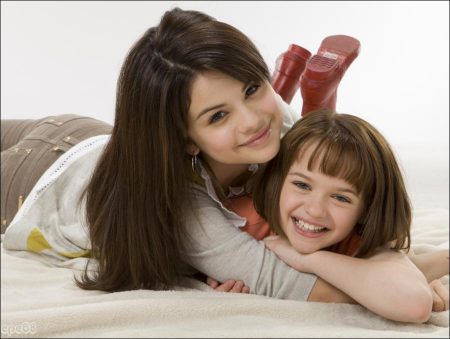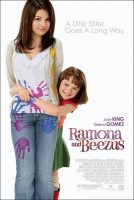Taglines: A little sister goes a long way.
Based on the “Ramona” series of novels written by Beverly Cleary. As everyone knows, Ramona Quimby lives on Klickitat Street. The stories of her adventures begin in Beezus and Ramona, where Beezus, who is just turning ten, finds four-year-old Ramona an exasperating little sister.
First published over 50 years ago, Beverly Cleary’s books have entertained several generations of readers. The cast and filmmakers of the first major motion picture based on Cleary’s series – Ramona and Beezus – typifies the books’ cross-generational appeal. The film’s Ramona, Joey King, began reading the book series before she was cast in the role. Selena Gomez, the on-screen Beezus, had read the books in elementary school. “I love how Beverly writes the characters,” says the popular singer-actress. “We wanted to do justice to Beverly and her work, and to make her proud. We all did our homework and worked really hard to be true to the characters. I think this movie is going to be a fun family experience.”
“I grew up on the Ramona books, as did my mother who passed them down to me,” says Ginnifer Goodwin, who plays Ramona and Beezus’ Aunt Bea. “I think the way the books are passed down from parent to child is what’s magical about the whole series. The thing that really struck me when I reread the books was how Beverly Cleary captured the childhood experience.”
For the filmmakers, the process of turning the books into a major motion picture brought up strong feelings of nostalgia. “It’s a unique privilege to be able to make a movie that’s based on something so integral to one’s childhood,” says producer Alison Greenspan, who worked tirelessly to secure the motion picture rights to the beloved books.
Another example of the filmmakers’ connection to Ramona and her world (and there are many more): When director Elizabeth Allen was five and home sick with the chicken pox, her mother gave her the Ramona books. Allen admits, “I think I actually stayed home from school an extra day so I could finish up the series!”
Over the years, Cleary had been presented with many opportunities to option the book rights, but she remained reluctant … until a letter arrived from producer Denise Di Novi. Having successfully brought to the screen the well-received and family-friendly The Sisterhood of the Traveling Pants, Eloise, Little Women and James and the Giant Peach, Di Novi’s track record in bringing to life these classic books for young people, won Cleary’s confidence that the author’s books would be in the right hands.
Still, it took several trips to Cleary’s home, numerous phone calls, and over two years to secure the film rights to the books. “We tried to convince Mrs. Cleary we would take great care and be respectful, and make the movie in a way that was true to the material,” says Greenspan. “Denise [Di Novi]’s credits and the movies we’ve made together helped convince her that we would be able to do it.”
“Working with Denise, Alison and [director] Liz Allen looked like a good fit for what [Mrs. Cleary] envisioned a movie about Ramona would be, and would stay true to her stories,” says Malcolm Cleary, the author’s son, who visited the set several times during filming. Malcolm also makes an appearance in the film as a guest at a wedding.
Creating Klickitat Street
The filmmakers promised Beverly Cleary they would be true to the books’ Portland, Oregon setting. While the film was shot in Vancouver, Canada, every effort was made to double Ramona’s hometown – and every shot had to pass the “would this exist in Portland?” test. The filmmakers transformed a quaint residential street in Vancouver’s picturesque Dunbar neighborhood into Ramona Quimby’s beloved Klickitat Street. The production took over a dozen houses in the neighborhood for sets, office space and housing. While Vancouver is the third largest production center in North America, the 27 days the production spent at the “Klickitat Street” location set a record for shooting in a residential area of the city.
The entire cast enjoyed their Klickitat Street experience – their home away from home. The ‘Quimby’ house had been home to one family for many years, giving the locale, says Di Novi, a “great vibration. It was our own little neighborhood and we started to feel like we lived there.”
“It was like the neighborhood Beverly Cleary imagined,” says Duhamel. “It was nice because we had the house and backyard we were shooting in, and if you wanted something to eat, you just went to the house next door. My dressing room was in the basement of the next house over. It was very much a neighborhood movie.”
Much of the film’s action plays from exteriors to home interiors, and back outside again, which mirrors the structure of Cleary’s books. “So much of what was appealing about Beverly’s books is that they’re about the camaraderie of the neighbors,” says Elizabeth Allen. “The residents embraced us, and it felt like we were part of the neighborhood. And that’s reflected on screen.”
In the Ramona books, the Quimbys have a front lawn, which meant that the filmmakers had to move a beautiful rock garden situated in front of the location house, to the backyard. The backyard itself was extended into a neighbor’s yard, to highlight a tree on which Ramona and Aunt Bea have an important chat. “One of the reasons we chose this location,” says production designer Brent Thomas, “is that the neighbors behind the house had a fantastic tree. We moved the fence back thirty feet to include the tree in the Quimby’s yard. And we added a branch that Ramona and Aunt Bea could sit on.”
The filmmakers extensively remodeled the house’s interior, removing several walls and structural beams to facilitate camera movements. Director of photography John Bailey, ASC says, “Shooting in practical locations is a double-edged sword. The wonderful thing about a real location is you can integrate the interior and exterior spaces seamlessly. The disadvantage is you’re constrained by the architecture of the space: it’s more difficult to put the camera where you’d like it and, [shooting in our location house] tested our creativity to come up with different ways of shooting the scenes. We might have fallen into more traditional routines if we’d been working on a set.”
Ramona Quimby is a little girl with a huge imagination – and in RAMONA AND BEEZUS, says Elizabeth Allen, “We get to unzip Ramona’s head and see into her brain.” To bring Ramona’s vivid imagination to life, Allen came up with a unique visual approach that largely eschews the computer generated imagery audiences have grown accustomed to seeing. “I prefer the tactile quality you get from models and toys, and as I started to explore that idea, I realized it was a better way to go creatively,” Allen explains. “Even if I had carte blanche [to use expensive CGI], I would still have made the choice to use more practical techniques. I thought that was the best way to depict Ramona’s special way of seeing the world.”
Ramona and Beezus (2010)
Directed by: Elizabeth Allen
Starring: Joey King, Selena Gomez, John Corbett, Bridget Moynahan, Ginnifer Goodwin, Hutch Dano, Sierra McCormick, Josh Duhamel, Kathryn Zenna, Janet Wright, Hutch Dano, Garnet Harding
Screenplay by: Beverly Cleary, Laurie Craig
Production Design by: Brent Thomas
Cinematography by: John Bailey
Film Editing by: Jane Moran
Costume Design by: Patricia Hargreaves
Set Decoration by; Carol Lavallee
Art Direction by: Shannon Grover
Music by: Mark Mothersbaugh
MPAA Rating: G for general audience.
Studio: 20th Century Fox
Release Date: July 23, 2010





